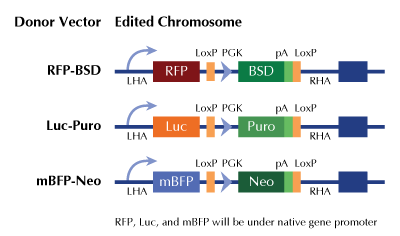LOXL1 Human Gene Knockout Kit (CRISPR)
CAT#: KN209830BN
LOXL1 - human gene knockout kit via CRISPR, HDR mediated
Functional Cassette: GFP-puro Luciferase-Puro RFP-BSD
HDR-mediated knockout kit validation
USD 1,657.00
4 Weeks*
Specifications
| Product Data | |
| Format | 2 gRNA vectors, 1 mBFP-Neo donor, 1 scramble control |
| Donor DNA | mBFP-Neo |
| Symbol | LOXL1 |
| Locus ID | 4016 |
| Components |
KN209830G1, LOXL1 gRNA vector 1 in pCas-Guide CRISPR vector KN209830G2, LOXL1 gRNA vector 2 in pCas-Guide CRISPR vector KN209830BND, donor DNA containing left and right homologous arms and mBFP-Neo functional cassette. GE100003, scramble sequence in pCas-Guide vector |
| Disclaimer | These products are manufactured and supplied by OriGene under license from ERS. The kit is designed based on the best knowledge of CRISPR technology. The system has been functionally validated for knocking-in the cassette downstream the native promoter. The efficiency of the knock-out varies due to the nature of the biology and the complexity of the experimental process. |
| Reference Data | |
| RefSeq | NM_005576 |
| UniProt ID | Q08397 |
| Synonyms | LOL; LOXL |
| Summary | This gene encodes a member of the lysyl oxidase family of proteins. The prototypic member of the family is essential to the biogenesis of connective tissue, encoding an extracellular copper-dependent amine oxidase that catalyzes the first step in the formation of crosslinks in collagen and elastin. The encoded preproprotein is proteolytically processed to generate the mature enzyme. A highly conserved amino acid sequence at the C-terminus end appears to be sufficient for amine oxidase activity, suggesting that each family member may retain this function. The N-terminus is poorly conserved and may impart additional roles in developmental regulation, senescence, tumor suppression, cell growth control, and chemotaxis to each member of the family. Mutations in this gene are associated with exfoliation syndrome. [provided by RefSeq, Jan 2016] |
Documents
| Product Manuals |
| FAQs |
| SDS |
Resources
Other Versions
| SKU | Description | Size | Price |
|---|---|---|---|
| KN209830 | LOXL1 - human gene knockout kit via CRISPR, HDR mediated |
USD 1,657.00 |
|
| KN209830LP | LOXL1 - human gene knockout kit via CRISPR, HDR mediated |
USD 1,657.00 |
|
| KN209830RB | LOXL1 - human gene knockout kit via CRISPR, HDR mediated |
USD 1,657.00 |
|
| KN409830 | LOXL1 - KN2.0, Human gene knockout kit via CRISPR, non-homology mediated. |
USD 1,657.00 |
|
| GA102723 | LOXL1 CRISPRa kit - CRISPR gene activation of human lysyl oxidase like 1 |
USD 1,657.00 |
{0} Product Review(s)
Be the first one to submit a review






























































































































































































































































 Germany
Germany
 Japan
Japan
 United Kingdom
United Kingdom
 China
China
